RUSSIAN PIONEERS OF SOUND ART AND MUSICAL TECHNOLOGY IN 1910-1930
24.01-24.02.2014. GENERATION Z : ReNoise, CTM14 Festival, Bethanien, Berlin, Germany
9.06-20.07.2011. GENERATION Z at OSA ARCHIVUM, Budapest, Hungary
11.08-15.05.2011. GENERATION_Z. at Moscow Polytechnic Museum
25.02-25.04.2010. GENERATION_Z in Peter and Paul Fortress, PRO ARTE Foundation, Saint-Petersburg
22-24.01.2010. GENERATION_Z at the Central House of Painters, Moscow
24.09-9.2009. GENERATION_Z at the Third Moscow Biennale of contemporary art
25.09.2008-4.01.2009. SOUND_in_Z as a part the exhibition From one Revolution to Another at Palais de Tokyo, Paris
GENERATION Z : ReNoise Leporello. CTM14 Festival, Berlin, 2014 (English, German)
GENERATION Z : ReNoise Booklet. CTM14 Festival, Berlin, 2014 (English)
GENERATION Z Booklet. OSA Archivum, Budapest, 2011 (English and Hungarian)
GENERATION Z Booklet. Polytechnic Museum, Moscow, 2011 (Russian)
GENERATION Z Booklet. Pro Arte, St. Petersburg, 2010 (Russian)
SOUND IN Z. Palais de Tokyo, Paris, 2008 (English, French)
THE PRESS
 Generation Z exhibition is a part of an ongoing project by Andrei Smirnov and Liubov Pchelkina that is attempting to reconstruct the censored history and culture of the Russian artistic Utopia of the 1910-1920s – a kind of 'network culture' of revolutionaries in art who realized seemingly unrealizable projects in sound, invented new musical machines, and who explored concepts and methods that offered a promising basis for future scientific and cultural development. The exhibition offers an introduction to some of the key figures of the period and their areas of research. Generation Z exhibition is a part of an ongoing project by Andrei Smirnov and Liubov Pchelkina that is attempting to reconstruct the censored history and culture of the Russian artistic Utopia of the 1910-1920s – a kind of 'network culture' of revolutionaries in art who realized seemingly unrealizable projects in sound, invented new musical machines, and who explored concepts and methods that offered a promising basis for future scientific and cultural development. The exhibition offers an introduction to some of the key figures of the period and their areas of research.
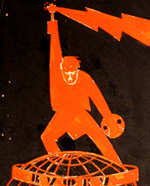 Living in famine, extreme cold and poverty, creative people were dreaming about the future country, where everything would be different – a perfect man, a universal language, real machines. We call them Generation Z. The letter Z is in many ways emblematic of the period. Z is for zigzag, the spark; it is the symbol of energy, of radio transmissions, of electrical charges and of lightning. It became ubiquitous on book covers, posters and in paintings during the 1920s. At the same time it is evocative of the anarchical, adventurous ideas and projects that went on during this period and that would have been i nconceivable in other times – projects that were often anonymous and many of which have largely been forgotten. Artists, poets, musicians and architects rushed enthusiastically into the new reality, studying physics and mathematics, embracing sciences concerning the nature of light and sound, and developing theories about what became known as ‘the Art of the Future'. Many were inspired by the analytical minds of Renaissance. Living in famine, extreme cold and poverty, creative people were dreaming about the future country, where everything would be different – a perfect man, a universal language, real machines. We call them Generation Z. The letter Z is in many ways emblematic of the period. Z is for zigzag, the spark; it is the symbol of energy, of radio transmissions, of electrical charges and of lightning. It became ubiquitous on book covers, posters and in paintings during the 1920s. At the same time it is evocative of the anarchical, adventurous ideas and projects that went on during this period and that would have been i nconceivable in other times – projects that were often anonymous and many of which have largely been forgotten. Artists, poets, musicians and architects rushed enthusiastically into the new reality, studying physics and mathematics, embracing sciences concerning the nature of light and sound, and developing theories about what became known as ‘the Art of the Future'. Many were inspired by the analytical minds of Renaissance.
In 1918 Lunacharsky, the people's commissar of education, officially proclaimed that the arts should be developed on an experimental basis. As he told the composer Sergei Prokofiev: ‘You are revolutionary in music as we are revolutionary in life – we should work together'. These new trends strongly affected Russian political and social spheres, and also played a role in the communal transformation of public consciousness. Special institutions were founded for the development and improvement of ‘the New Human', engaged in the mastering and perfection of professional motion in sports, in working life, military activity, musical performance and so on. While some ideas were little more than science fiction at the time, many projects and proposals were more immediately viable or were actively seeking to develop the technology necessary to deliver them.
LEON THEREMIN 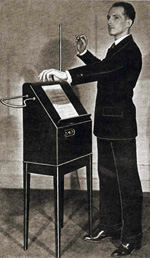 While the history of Russian post-revolutionary avant-garde art and music is fairly well documented, the inventions and discoveries, names and destinies of the community of researchers of sound, creators of musical machines and noise orchestras and founders of new musical technologies have been largely forgotten except, perhaps, Leon Theremin, well known as an inventor of the first commercially produced electronic musical instrument, the Theremin (1920). As composer and author Albert Glinsky asserts, ‘this frequently clumsy instrument was the first foray into the brave new world of electronic music.' Its arrival heralded a new, technologically based trend in the arts. As a physicist, musician and engineer he worked on the development of innumerable projects, often trying to combine music with colour, with gesture, scent and touch. Having worked at the crossroads of creative technology and espionage, it is hardly possible today to imagine any synthesizers, burglar alarms or automatic doors without his pioneering research. While the history of Russian post-revolutionary avant-garde art and music is fairly well documented, the inventions and discoveries, names and destinies of the community of researchers of sound, creators of musical machines and noise orchestras and founders of new musical technologies have been largely forgotten except, perhaps, Leon Theremin, well known as an inventor of the first commercially produced electronic musical instrument, the Theremin (1920). As composer and author Albert Glinsky asserts, ‘this frequently clumsy instrument was the first foray into the brave new world of electronic music.' Its arrival heralded a new, technologically based trend in the arts. As a physicist, musician and engineer he worked on the development of innumerable projects, often trying to combine music with colour, with gesture, scent and touch. Having worked at the crossroads of creative technology and espionage, it is hardly possible today to imagine any synthesizers, burglar alarms or automatic doors without his pioneering research.
Theremin's life story is a fascinating and well-documented one, not least for his secret work for NKVD (the KGB). In June 1926, Theremin has finished his diploma project The System of Dalnovidenie - the first Soviet TV system. Shortly after that Theremin's chief professor Ioffe has patented the Thereminvox and managed an international trip for Theremin. Most of his inventions he did in US between 1928 and 1938. In his New York studio he has developed numerous musical instruments and scientific gadgets. Among them commercial RCA Theremins , the Rhythmicon - first rhythm machine ever made, the Terpsitone – a musical platform for dancers to control sound through the motion of their bodies.
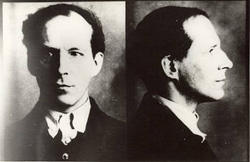 August 31, 1938 he was illegally taken on board Starry Bolshevik ship on which he has transported over 1000 kilograms of electronic equipment to Russia. His intension was to develop an electronic music studio in Soviet Russia. It is not surprising that all equipment was confiscated by Soviet customs. Shortly after arrival in March 1939 Leon Theremin was arrested and condemned for 8 years of GULAG camps. Fortunately after one year in Kolima (the worst place in Siberia) he was moved to Moscow “Sharaga” – special prison for scientists. After release in 1947 he remained to work for KGB until his retirement in 1962 when he moved to Acoustical Laboratory at Moscow State Conservatory (former NIMI), where he tried to revive most of his American inventions and research. On April 1967 an article about him was published by the New York Times, which caused a fast and only possible in the USSR reaction: Leon Theremin was removed from his position and kicked out of the Moscow State Conservatory. The rest of his life Leon Theremin has spent working at Moscow State University in a position of technician at the Physics Department. August 31, 1938 he was illegally taken on board Starry Bolshevik ship on which he has transported over 1000 kilograms of electronic equipment to Russia. His intension was to develop an electronic music studio in Soviet Russia. It is not surprising that all equipment was confiscated by Soviet customs. Shortly after arrival in March 1939 Leon Theremin was arrested and condemned for 8 years of GULAG camps. Fortunately after one year in Kolima (the worst place in Siberia) he was moved to Moscow “Sharaga” – special prison for scientists. After release in 1947 he remained to work for KGB until his retirement in 1962 when he moved to Acoustical Laboratory at Moscow State Conservatory (former NIMI), where he tried to revive most of his American inventions and research. On April 1967 an article about him was published by the New York Times, which caused a fast and only possible in the USSR reaction: Leon Theremin was removed from his position and kicked out of the Moscow State Conservatory. The rest of his life Leon Theremin has spent working at Moscow State University in a position of technician at the Physics Department.
State Institute for Musical Science (GIMN) 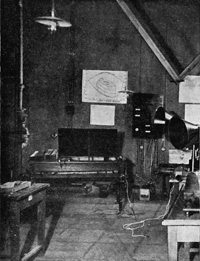 While the career of Theremin the physicist began at the Institute for Physics and Technology in Petrograd, his musical career has begun in Moscow, at the State Institute for Musical Science (GIMN) which was founded in Moscow in 1921 in an attempt to centralize all activities related to musical science including disciplines such as acoustics, musicology, psychology, physiology, construction of new musical instruments and ethnomusicology. Nikolai Garbuzov was elected director. While the career of Theremin the physicist began at the Institute for Physics and Technology in Petrograd, his musical career has begun in Moscow, at the State Institute for Musical Science (GIMN) which was founded in Moscow in 1921 in an attempt to centralize all activities related to musical science including disciplines such as acoustics, musicology, psychology, physiology, construction of new musical instruments and ethnomusicology. Nikolai Garbuzov was elected director.
From the beginning GIMN was oriented towards academic research.
Among the many researchers and inventors involved were Leon Theremin, Arseny Avraamov, Leonid Sabaneev, Peter Zimin, Nikolai Bernstein, Pavel Leiberg, Boris Krasin, Emily Rosenov, Mikhail Gnesin and many others. Numerous research projects were conducted, articles published and experimental devices built, including a harmonium in natural (overtone) scale, and a quarter-tone harmonium with two keyboards. Sergei Rzevkin built his radio-harmonium on cathode valves, which was the second electronic musical instrument to be built in Russia after the invention of the theremin. It was a sort of three-voice oscillator, capable of producing polyphonic chords in any temperament. Nikolai Garbuzov built a device to study the phenomena of synopsia (colour hearing).
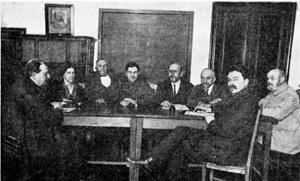 In 1931 GIMN was closed and in 1933 Garbuzov established a new Research Institute for Musical Science (NIMI) at Moscow State Conservatory where in 1940s it was renamed as the Acoustical Laboratory. In the realm of music and its technology GIMN/NIMI was the highest-level organization in Moscow. Projects from all over Soviet Russia seeking a patent or financial support needed a positive review from the appropriate GIMN/NIMI experts. As many of these experts were involved in similar research or had different aesthetic views, their responses were often negative, based on biased opinions and self-interest rather than scholarship, discourse and the greater good. In 1931 GIMN was closed and in 1933 Garbuzov established a new Research Institute for Musical Science (NIMI) at Moscow State Conservatory where in 1940s it was renamed as the Acoustical Laboratory. In the realm of music and its technology GIMN/NIMI was the highest-level organization in Moscow. Projects from all over Soviet Russia seeking a patent or financial support needed a positive review from the appropriate GIMN/NIMI experts. As many of these experts were involved in similar research or had different aesthetic views, their responses were often negative, based on biased opinions and self-interest rather than scholarship, discourse and the greater good.
LABORATORY OF HEARING 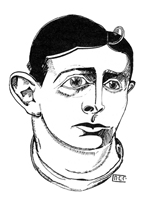 In 1916 a student at the Neurological Institute in Petrograd Denis Kaufman (1896-1954) (aka Dziga Vertov) attempted what would now be called sound poetry and audio art. As he put it: ‘I decided to include the entire audible world into the concept of “Hearing.” It was during this time that I attempted to draw up the sounds of a lumber-mill. [...] I tried to describe the audio impression of the lumber-mill in the way a blind person would perceive it. In the beginning I wrote down words, but then I attempted to capture all of these noises with letters. [...] It also concerned my experiments with gramophone recordings, where from the separate fragments of recordings on In 1916 a student at the Neurological Institute in Petrograd Denis Kaufman (1896-1954) (aka Dziga Vertov) attempted what would now be called sound poetry and audio art. As he put it: ‘I decided to include the entire audible world into the concept of “Hearing.” It was during this time that I attempted to draw up the sounds of a lumber-mill. [...] I tried to describe the audio impression of the lumber-mill in the way a blind person would perceive it. In the beginning I wrote down words, but then I attempted to capture all of these noises with letters. [...] It also concerned my experiments with gramophone recordings, where from the separate fragments of recordings on 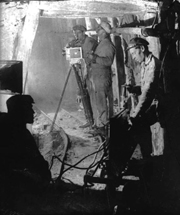 gramophone disks a new composition was created. But I was not satisfied experimenting with available prerecorded sounds'. Being frustrated, he has switched to film to o rganize not the audible, but the visible world. gramophone disks a new composition was created. But I was not satisfied experimenting with available prerecorded sounds'. Being frustrated, he has switched to film to o rganize not the audible, but the visible world.
It was Vertov who in 1929 did the first field sound recording by means of portable sound-on-film equipment, specially built for him by inventor A.Shorin, allowed him to record actual urban sounds: industrial noises in the harbor, sounds of the railroad and the railway station, streets and trams to produce the film ‘Enthusiazm' (1930), which became the first approach to what would now be called ‘Musique Concrete', invented by Pierre Schaeffer in France in 1948 and initiated development of electro-acoustic music.
REVARSAVR
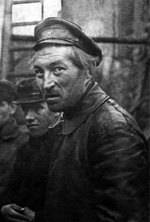 Arseny Avraamov (Krasnokutsky) (1885-1944) was a composer, performance instigator, music journalist and creator of the first ever artificial soundtrack. In a series of articles from 1914-1916 he developed the theory of microtonal ‘Ultrachromatic' music and invented special instruments to perform it. Shortly after the October Revolution Avraamov proposed to the Commissar of Education, Anatoly Lunacharsky, a project to burn all pianos – symbols of the despised twelve-tone, octave-based ‘well tempered' scale, which he believed had adversely affected human hearing for several hundred years. Arseny Avraamov (Krasnokutsky) (1885-1944) was a composer, performance instigator, music journalist and creator of the first ever artificial soundtrack. In a series of articles from 1914-1916 he developed the theory of microtonal ‘Ultrachromatic' music and invented special instruments to perform it. Shortly after the October Revolution Avraamov proposed to the Commissar of Education, Anatoly Lunacharsky, a project to burn all pianos – symbols of the despised twelve-tone, octave-based ‘well tempered' scale, which he believed had adversely affected human hearing for several hundred years.
During the 1910s and 1920s Avraamov experimented with 'prepared' pianos, harmoniums and various noise sources as well as a symphony orchestra to develop new approaches to organizing sound that are very similar to recent techniques of electroacoustic and spectral music. He explored new genres of music devised for urban contexts and presented around the built environment, including the acclaimed Symphony of Sirens.
As early as 1916, in the article ‘Upcoming Science of Music and the New Era in the History of Music', Avraamov predicted and explained different approaches to synthesize sound, including some of today's latest techniques of physical modeling. It was Avraamov who completed the first artificial Graphical soundtrack in 1930 based on geometric profiles and ornaments – produced purely through drawing methods. This was achieved by means of shooting still images of drawn sound waves on an animation stand.
LEONARDO DA VINCI SOCIETY
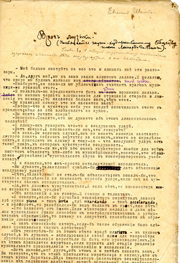 In the spring of 1917 in Petrograd the Leonardo da Vinci Society was founded by Arseny Avraamov and the young inventor Evgeny Sholpo (1891-1951) accompanied by the mathematician and musicologist Sergei Dianin. Their objective was to unite efforts to produce a revolution in music theory and techniques based on the cross-connection of the arts and sciences. They declared that academic views on music theory were dull and scholastic, and that techniques relating to it were old fashioned, proclaiming that both were becoming increasingly outdated. In the summer of 1917 in Petrograd Evgany Sholpo wrote a science-fiction essay entitled ‘The Enemy of Music' in which he described a sound machine named the Mechanical Orchestra, capable of synthesizing any sound and producing music according to a special graphical score without any need for a performer. The instrument was based on the same principles as the ANS Synthesizer, built 35 years later by Evgeny Murzin. According to Sholpo's description the instrument incorporated a set of sine wave oscillators, based on numerous Helmholtz tuning forks, adjusted on fixed frequencies, forming a discrete scale, covering the whole audible range with intervals between successive pitches unperceivable to the human ear. Control over the system and the process of sound synthesis was to be carried out by means of a special graphical score with the diagram, representing a spectrum of a sound by means of cut-out transparent strips, having appropriate shape and slopes, allowing a complete set of sine wave tones to be operated synchronously and independently, controlling the sound on a spectral level, directly manipulating the overtones, erasing the difference between the pitch-based harmony structures and the spectral tissue of a sound. In the spring of 1917 in Petrograd the Leonardo da Vinci Society was founded by Arseny Avraamov and the young inventor Evgeny Sholpo (1891-1951) accompanied by the mathematician and musicologist Sergei Dianin. Their objective was to unite efforts to produce a revolution in music theory and techniques based on the cross-connection of the arts and sciences. They declared that academic views on music theory were dull and scholastic, and that techniques relating to it were old fashioned, proclaiming that both were becoming increasingly outdated. In the summer of 1917 in Petrograd Evgany Sholpo wrote a science-fiction essay entitled ‘The Enemy of Music' in which he described a sound machine named the Mechanical Orchestra, capable of synthesizing any sound and producing music according to a special graphical score without any need for a performer. The instrument was based on the same principles as the ANS Synthesizer, built 35 years later by Evgeny Murzin. According to Sholpo's description the instrument incorporated a set of sine wave oscillators, based on numerous Helmholtz tuning forks, adjusted on fixed frequencies, forming a discrete scale, covering the whole audible range with intervals between successive pitches unperceivable to the human ear. Control over the system and the process of sound synthesis was to be carried out by means of a special graphical score with the diagram, representing a spectrum of a sound by means of cut-out transparent strips, having appropriate shape and slopes, allowing a complete set of sine wave tones to be operated synchronously and independently, controlling the sound on a spectral level, directly manipulating the overtones, erasing the difference between the pitch-based harmony structures and the spectral tissue of a sound.
The Central Institute of Labour (CIT)
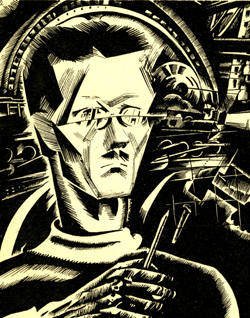 The Central Institute of Labour (CIT) was established in 1920 by the writer, politician and polymath Alexei Gastev (1882-1939), who was one of the most popular and outstanding proletarian poets of the early post-revolutionary Russia. He was convinced that CIT was his main artistic creation. Fascinated by Taylorism and Fordism, he has led a popular movement for the ‘scientific organization of labor' (NOT) to represent a Marxian variant of cybernetics. It was Gastev who coined the term Bio-mechanics, which was widely used then in the psychology of labour as well as in the field of theatre, most evidently in the work of producer, director and actor Vsevolod Meyerhold. It was scientific research with an interdisciplinary and broad-ranging agenda. And at the foundation of this approach lay a powerful manmachine metaphor associating, in particular, with the concept of Organoprojection (1919) by Pavel Florensky - Russian The Central Institute of Labour (CIT) was established in 1920 by the writer, politician and polymath Alexei Gastev (1882-1939), who was one of the most popular and outstanding proletarian poets of the early post-revolutionary Russia. He was convinced that CIT was his main artistic creation. Fascinated by Taylorism and Fordism, he has led a popular movement for the ‘scientific organization of labor' (NOT) to represent a Marxian variant of cybernetics. It was Gastev who coined the term Bio-mechanics, which was widely used then in the psychology of labour as well as in the field of theatre, most evidently in the work of producer, director and actor Vsevolod Meyerhold. It was scientific research with an interdisciplinary and broad-ranging agenda. And at the foundation of this approach lay a powerful manmachine metaphor associating, in particular, with the concept of Organoprojection (1919) by Pavel Florensky - Russian 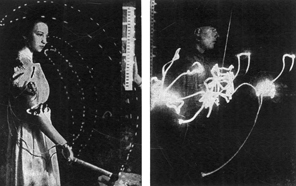 Orthodox theologian, philosopher, mathematician and inventor, executed by NKVD in late 1930s. Orthodox theologian, philosopher, mathematician and inventor, executed by NKVD in late 1930s.
CIL was extremely unusual institution where the same space was shared by selflessly experimenting old fanatics-inventors and fascinated teenagers. Alongside with physiological laboratory there were laboratories for sensorics, psychotechnics and education. To achieve maximum results a whole bunch of “multimedia” tools and “interactive” gadgets were involved including all sorts of photo and filming techniques, cards with precise instructions, imitating apparatus (cabins of the cars, planes, various control panels) to produce training without the instructor in a very short terms.
During the 1920s, in one of Gastev's exhibitions, entitled Art of Movement, stereo images demonstrated the physical trajectories of tools, hammers, weapons, the corporeal joints of workers, pianists and sportsmen. Most of this documentary was produced by Nikolai Bernstein 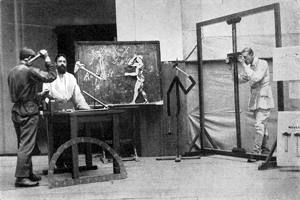 (1896–1966) - the Institute's leading physiologist, who conducted a series of experiments that measured the trajectories and speeds of human limbs, while his subjects performed various labour tasks. (1896–1966) - the Institute's leading physiologist, who conducted a series of experiments that measured the trajectories and speeds of human limbs, while his subjects performed various labour tasks.
Although by 1938 CIL prepared over 500 000 qualified workers in 200 professions as well as 20 000 instructors of industrial training in 1700 educational centers, the toleration of state officials finished. Alas, the totalitarian State was not interested in the Utopia based on creative network of perfect, socially-engineered Cyborgs with liberated minds. Alexei Gastev was arrested in 1938, his institute was closed, documents were destroyed. Among thousands of other outstanding people, Gastev was executed on 15 April, 1939.
PROJECTIONISM
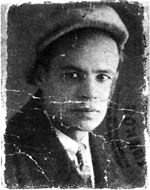 The ideas, projects and artworks created during 1910-20-s are often considered utopian. However, there is no general definition or style that can lay claim to characterize the art of the late 1910s and 1920s. Nor does this time interval fit neatly into any system of representation about the unity of culture or its progressive development. A term that sought to capture the essence of the period was proposed by the artist and philosopher Solomon Nikritin (1898-1965). Projectionism (from the Latin 'projectus') was intended to reflect the urge to rush ahead, or more accurately, to rush into the future. He applied this term not only to new approaches in painting and methods of art criticism, but also to the methodology of constructing a new society, to which it was considered necessary to aspire. In 1919 Nikritin developed his fundamental theory of Projectionism. According to his philosophy, the rational essence of nature is the highest goal of technology and culture. In his manifesto he asserted: ‘The Artist is not a producer of consumer goods (a cupboard, a picture), but of (PROJECTIONS) METHOD – the organization of matter.' The ideas, projects and artworks created during 1910-20-s are often considered utopian. However, there is no general definition or style that can lay claim to characterize the art of the late 1910s and 1920s. Nor does this time interval fit neatly into any system of representation about the unity of culture or its progressive development. A term that sought to capture the essence of the period was proposed by the artist and philosopher Solomon Nikritin (1898-1965). Projectionism (from the Latin 'projectus') was intended to reflect the urge to rush ahead, or more accurately, to rush into the future. He applied this term not only to new approaches in painting and methods of art criticism, but also to the methodology of constructing a new society, to which it was considered necessary to aspire. In 1919 Nikritin developed his fundamental theory of Projectionism. According to his philosophy, the rational essence of nature is the highest goal of technology and culture. In his manifesto he asserted: ‘The Artist is not a producer of consumer goods (a cupboard, a picture), but of (PROJECTIONS) METHOD – the organization of matter.'
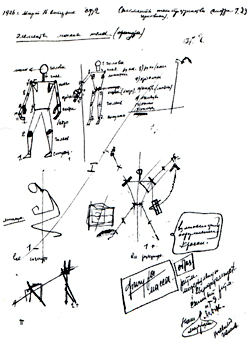 The method, therefore, invented by the artist, becomes the purpose of the creative process. The intention was for new ideas to transfer creative energy into further development. In the context of ‘projecting the method' even faults and paradoxes gained a new constructive sense and value. In the early 1920s much project-based research took place that could be considered within the framework of Projectionism, including Alexei Gastev's Art of Movement exhibitions, the concert-lectures by Leon Theremin, and Arseny Avraamov's concert series Music of the Future, in which the author demonstrated his practical ideas regarding the future of musical harmony and techniques, rather than presenting finished musical pieces. The method, therefore, invented by the artist, becomes the purpose of the creative process. The intention was for new ideas to transfer creative energy into further development. In the context of ‘projecting the method' even faults and paradoxes gained a new constructive sense and value. In the early 1920s much project-based research took place that could be considered within the framework of Projectionism, including Alexei Gastev's Art of Movement exhibitions, the concert-lectures by Leon Theremin, and Arseny Avraamov's concert series Music of the Future, in which the author demonstrated his practical ideas regarding the future of musical harmony and techniques, rather than presenting finished musical pieces.
In fact Nikritin's ideas are reminiscent of Alexander Bogdanov's project of Tectology. What they shared was a desire to develop a universal science of organization and analysis through a search for structural similarities in all spheres of knowledge. Rejecting traditional arts, Nikritin proclaims the universal principles, common for all future arts, as being related to subjects such as sound, image, biomechanics and social engineering. The new language of art, for him, was based on terms such as stream, dynamics, density. Nikritin tried to develop a typology and classification system of human movements and gestures, colour pallets, sounds (mainly related to the human voice) as well as emotional states, based on the principles and terms of biomechanics, musical harmony and acoustics.
PROJECTION THEATRE
The practical implementation of the theory was realized at the Studio of the Projection Theater established by Solomon Nikritin and Sergey Luchishkin on January 10, 1922 within the Higher Art and Technical Studios. It was one of the most avant-garde theater groups of the time. The Projectionists organized a theater of “projects”, that reduced and dissected the fundamentals of rhythmic movement and individual speech sounds, playing in and around mobile, abstract sets. As Luchishkin explained: "We started to implement our experimental concepts by working up action scores by analogy with a piece of music, composing them out of different parts together with different rhythmo-dynamic characteristics. After that, we looked for the form of plastic expression in  each part within the movement of the body, for the development of this movement, and for its nuances and transitions, including vocal resonance. All this was tinged by the emotional score which became the basis of the entire action". Many instances of the use of current multimedia technologies were already being explored in the performances of the Projection Theatre in the 1920s. To create the most complicated scores of sounds, gestures, movements and emotional states needed for his research, actors were involved in a daily routine of exercises and psychological training. Specially made diagrams specified the distribution of various emotions in time such as anger, melancholy and sadness by representing them as percentages on a graph. Large screens behind the stage were intended to produce a dynamical film projection as a part of the performance and virtual characters from the film projection appeared to interact with the actors on the stage. each part within the movement of the body, for the development of this movement, and for its nuances and transitions, including vocal resonance. All this was tinged by the emotional score which became the basis of the entire action". Many instances of the use of current multimedia technologies were already being explored in the performances of the Projection Theatre in the 1920s. To create the most complicated scores of sounds, gestures, movements and emotional states needed for his research, actors were involved in a daily routine of exercises and psychological training. Specially made diagrams specified the distribution of various emotions in time such as anger, melancholy and sadness by representing them as percentages on a graph. Large screens behind the stage were intended to produce a dynamical film projection as a part of the performance and virtual characters from the film projection appeared to interact with the actors on the stage.
In 1923 Projection Theatre became a department of the Central Institute of Labour (CIT), functioning as a proving ground for the development of the ideal Man of the Future. The purpose of the Projection Theatre was to teach the whole of society to master the human mind and body. Mastering CIT techniques and methodologies, practicing the most complicated scores of sounds, gestures, movements and emotional states, as a result of daily exercises and psycho-training, actors of the theatre played the role of alive models of the future socially-engineered Human-Machine.
NOISE ORCHESTRA
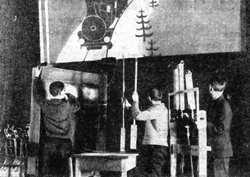 In 1921-23 performances of the Projection Theatre, the Foregger Studio as well as sound experiments at the Proletkult Studio, directed by Sergei Eisenstein, have provoke a fashion on Noise Music and Noise Orchestras. As Rene Fulop-Miller has noted in 1926: ‘The same idea also ruled the true proletarian music: it, too, emphasized the rhythms which corresponded to the universal and impersonal elements of humanity. The new music had to embrace all the noises of the mechanical age, the rhythm of the machine, the din of the great city and the factory, the whirring of driving-belts, the clattering of motors, and the shrill notes of motor-horns. In 1921-23 performances of the Projection Theatre, the Foregger Studio as well as sound experiments at the Proletkult Studio, directed by Sergei Eisenstein, have provoke a fashion on Noise Music and Noise Orchestras. As Rene Fulop-Miller has noted in 1926: ‘The same idea also ruled the true proletarian music: it, too, emphasized the rhythms which corresponded to the universal and impersonal elements of humanity. The new music had to embrace all the noises of the mechanical age, the rhythm of the machine, the din of the great city and the factory, the whirring of driving-belts, the clattering of motors, and the shrill notes of motor-horns.
Therefore, the Bolshevists very soon proceeded to construct special noise instruments, to form noise orchestras, to give the public a "real new music" instead of the usual old bourgeois individualistic "patchwork," and in this way to prepare the collective soul for the revelation of the holiest. They imitated all conceivable sounds from industry and technology and united them in peculiar fugues, in which a whole world of noise deafened the ear. In increasingly extended forms the new "machine music" made itself felt, and soon noise symphonies, noise operas, and noise festive performances were composed.'
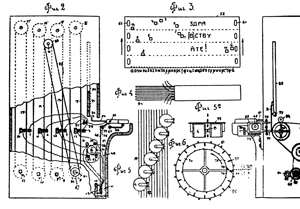 Many inventors patented new sound machines specially intended for performance of the Noise Music. Some devices based on electro-optical, electro-mechanical and newest electronic technologies were ahead of their time by decades. Among them the Electro-Musical Device invented by J.A. Pakhuchi (Patent #19675, filed December 26, 1929) with application of a buzzer and a pedal rheostat for change of intensity of a sound. ‘Mechanical keyboard instrument for the reproduction of speech, singing and various sounds' invented in 1925 by D.G. Tambovtsev (Patent N6309. Filed May 9, 1925) was a kind of proto-sampler, very similar to the famous Mellotron, popular in 1970-s. It comprises a system of infinite loops of steel wire with prerecorded sounds, movable against the poles of electromagnets (magnetic heads), corresponding to each key of the keyboard. N.M. Molodsov invented a ‘Device for sound on film reproduction, intended to create illusion of the spatial movement of sounding objects by means of sound film' (Copyright certificate on the invention N49350. Filed June 8, 1934). A.G. Mashkovich invented some extraordinary devices to produce sound effects. Electro - Optical Musical Instrument, invented by Sergeev in 1926, was very similar to the famous Rhythmicon, built by Leon Theremin in 1931 and based on principle of the optical siren. It was a kind of electro-optical sound synthesizer, incorporating a sequencer to program scores with complicated rhythms and harmonies. Many inventors patented new sound machines specially intended for performance of the Noise Music. Some devices based on electro-optical, electro-mechanical and newest electronic technologies were ahead of their time by decades. Among them the Electro-Musical Device invented by J.A. Pakhuchi (Patent #19675, filed December 26, 1929) with application of a buzzer and a pedal rheostat for change of intensity of a sound. ‘Mechanical keyboard instrument for the reproduction of speech, singing and various sounds' invented in 1925 by D.G. Tambovtsev (Patent N6309. Filed May 9, 1925) was a kind of proto-sampler, very similar to the famous Mellotron, popular in 1970-s. It comprises a system of infinite loops of steel wire with prerecorded sounds, movable against the poles of electromagnets (magnetic heads), corresponding to each key of the keyboard. N.M. Molodsov invented a ‘Device for sound on film reproduction, intended to create illusion of the spatial movement of sounding objects by means of sound film' (Copyright certificate on the invention N49350. Filed June 8, 1934). A.G. Mashkovich invented some extraordinary devices to produce sound effects. Electro - Optical Musical Instrument, invented by Sergeev in 1926, was very similar to the famous Rhythmicon, built by Leon Theremin in 1931 and based on principle of the optical siren. It was a kind of electro-optical sound synthesizer, incorporating a sequencer to program scores with complicated rhythms and harmonies.
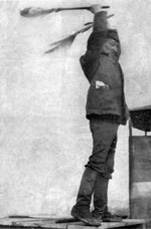 Perhaps the most well known project of the epoch of Noise Music was the Symphony of Sirens by Arseny Avraamov, inspired by the poetry of Alexei Gastev. It was first staged in the port town of Baku in 1922 in celebration of the 5th anniversary of the Revolution. This epic spectacle featured a cast of choirs, the foghorns of the entire Caspian flotilla, two batteries of artillery guns, a number of infantry regiments including a machine-gun division, hydroplanes, and all the town's factory sirens. The conductor, posted on a purpose-built tower, signaled various sound units with coloured flags and pistol shots. A central sound-machine called the 'Magistral' contained 50 steam whistles controlled by a crowd of musicians following 'text-scores'. Perhaps the most well known project of the epoch of Noise Music was the Symphony of Sirens by Arseny Avraamov, inspired by the poetry of Alexei Gastev. It was first staged in the port town of Baku in 1922 in celebration of the 5th anniversary of the Revolution. This epic spectacle featured a cast of choirs, the foghorns of the entire Caspian flotilla, two batteries of artillery guns, a number of infantry regiments including a machine-gun division, hydroplanes, and all the town's factory sirens. The conductor, posted on a purpose-built tower, signaled various sound units with coloured flags and pistol shots. A central sound-machine called the 'Magistral' contained 50 steam whistles controlled by a crowd of musicians following 'text-scores'.
A second performance of the Symphony took place in 1923 in Moscow. It was not as successful as the first because of a huge area covered with sirens and artillery leading to enormous distances between the performers. Military were not provided with as much ammunition as requested by Avraamov. The show overlapped with the demonstration dedicated to the 6th anniversary of the October Revolution. As Avraamov noted: “They gave us only 27 rounds of heavy cannon-fire! It is for the big drum! And there were no machine guns at all... only rifle fire! And there were two dozens airplanes buzzing over the Red Square”.
GRAPHICAL SOUND
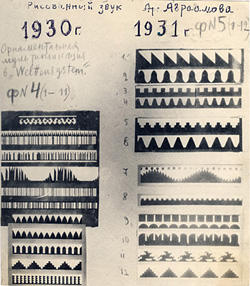 The late 1920s was also the period in which sound was being developed to accompany films and animations in Russia. Among the first Soviet sound movies ever created was ‘Piatiletka. Plan velikih rabot' (Plan of Great Works) by Abram Room.The group, working on this film in 1929 at Shorin's Central Laboratory of Wire Communication in Leningrad, included the painter, book illustrator and animator Mikhail Tsekhanovsky, the chief of the composer's brigade Arseny Avraamov and the inventor Evgeny Sholpo. When in October of that year the first roll of film was developed, it was Tsekhanovsky who voiced the idea: ‘What if we take some Egyptian or ancient Greek ornaments as a sound track? Perhaps we will hear some unknown archaic music?' He was referring to the shapes and outlines of vases and how these could be used as if wave forms to generate sound. It was at this precise moment that Graphical Sound techniques were invented. The next day they were already furiously at work on experiments in what they referred to variously as ‘ornamental', ‘drawn', ‘paper', ‘graphical', ‘artificial' or ‘synthetic' sound. By 1936 there were four main trends of Graphical Sound in Soviet Russia: hand-drawn Ornamental Sound (Avraamov, early Boris Yankovsky (1905-1973)); hand-made Paper Sound (Nikolai Voinov (1900-1958)); Variophone or automated Paper Sound (Evgeny Sholpo, Georgy Rimsky-Korsakov); and the spectral syntones technique (Boris Yankovsky). The late 1920s was also the period in which sound was being developed to accompany films and animations in Russia. Among the first Soviet sound movies ever created was ‘Piatiletka. Plan velikih rabot' (Plan of Great Works) by Abram Room.The group, working on this film in 1929 at Shorin's Central Laboratory of Wire Communication in Leningrad, included the painter, book illustrator and animator Mikhail Tsekhanovsky, the chief of the composer's brigade Arseny Avraamov and the inventor Evgeny Sholpo. When in October of that year the first roll of film was developed, it was Tsekhanovsky who voiced the idea: ‘What if we take some Egyptian or ancient Greek ornaments as a sound track? Perhaps we will hear some unknown archaic music?' He was referring to the shapes and outlines of vases and how these could be used as if wave forms to generate sound. It was at this precise moment that Graphical Sound techniques were invented. The next day they were already furiously at work on experiments in what they referred to variously as ‘ornamental', ‘drawn', ‘paper', ‘graphical', ‘artificial' or ‘synthetic' sound. By 1936 there were four main trends of Graphical Sound in Soviet Russia: hand-drawn Ornamental Sound (Avraamov, early Boris Yankovsky (1905-1973)); hand-made Paper Sound (Nikolai Voinov (1900-1958)); Variophone or automated Paper Sound (Evgeny Sholpo, Georgy Rimsky-Korsakov); and the spectral syntones technique (Boris Yankovsky).
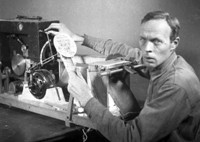 It was Avraamov who completed the first artificial sound tracks in 1930. The same year Evgeny Sholpo invents the Variophone. It was a continuation of research that Sholpo had been conducting since the 1910s when he was working on ‘Performer-less music'. The first version of Variophone was built in 1931 by Sholpo together with composer Georgy Rimsky-Korsakov (the son of the famous composer Nikolai Rimsky-Korsakov). It was capable of producing artificial soundtracks by means of automated Paper Sound techniques. It was Avraamov who completed the first artificial sound tracks in 1930. The same year Evgeny Sholpo invents the Variophone. It was a continuation of research that Sholpo had been conducting since the 1910s when he was working on ‘Performer-less music'. The first version of Variophone was built in 1931 by Sholpo together with composer Georgy Rimsky-Korsakov (the son of the famous composer Nikolai Rimsky-Korsakov). It was capable of producing artificial soundtracks by means of automated Paper Sound techniques.
M any soundtracks for movies and cartoons were created using the Variophone. Among the most accomplished pieces recorded with the Variophone in 1933-34 were ‘The Carburettor Suite' by G. Rimsky-Korsakov, ‘Waltz' by N.Timofeev, ‘Flight of the Valkyries' by Richard Wagner, and 6th Rhapsody by Franz Liszt. In 1941 during the blockade of Leningrad, together with composer Igor Boldirev, Sholpo synthesized one of his most experimental pieces – the soundtrack to the cartoon ‘Sterviatniki' (The Vultures). Although aesthetically these works are similar to Walter Carlos' ‘Switched-on Bach' (1968) and sound like 'eight-bit music', the main difference is in their timing. In 1918 Sholpo developed special tools - the Melograph and Autopianograph - to register the temporal characteristics of live musical performance. Much electronic music has a rigid tempo, like a metronome; Sholpo was able to simulate more subtle variations in tempo such as Rubato, Rallentando and Accelerando, based on his carful analyses of the live piano performances by the best pianists. any soundtracks for movies and cartoons were created using the Variophone. Among the most accomplished pieces recorded with the Variophone in 1933-34 were ‘The Carburettor Suite' by G. Rimsky-Korsakov, ‘Waltz' by N.Timofeev, ‘Flight of the Valkyries' by Richard Wagner, and 6th Rhapsody by Franz Liszt. In 1941 during the blockade of Leningrad, together with composer Igor Boldirev, Sholpo synthesized one of his most experimental pieces – the soundtrack to the cartoon ‘Sterviatniki' (The Vultures). Although aesthetically these works are similar to Walter Carlos' ‘Switched-on Bach' (1968) and sound like 'eight-bit music', the main difference is in their timing. In 1918 Sholpo developed special tools - the Melograph and Autopianograph - to register the temporal characteristics of live musical performance. Much electronic music has a rigid tempo, like a metronome; Sholpo was able to simulate more subtle variations in tempo such as Rubato, Rallentando and Accelerando, based on his carful analyses of the live piano performances by the best pianists.
Of all the early graphical sound pioneers Boris Yankovsky alone pursued the approach of spectral analysis, decomposition and re-synthesis. His concept was based on the belief that it is possible to develop a 'Universal Library of Sounds' similar to Mendeleev's Table of Chemical Elements. His curves were spectral templates, semiotic entities that could be combined to produce sound hybrids. As an option he developed several sound processing techniques including pitch shifting and time stretching based on the separation of spectral content and formants, resembling the recent computer music techniques of cross synthesis and the phase vocoder. To realize these ideas he invented a special instrument, the Vibroexponator – the most paradigm-shifting proposition of the mid 1930s.
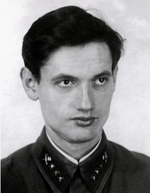 In 1939 Yankovsky met Evgeny Murzin (1914-1970) – a young inventor, fascinated by the idea of universal tool for sound synthesis and after a year of conversations the final concept of the future instrument was formulated. In 1957 Murzin completed and patented a photo-electronic musical instrument called the ANS Synthesizer. [Evgeny Murzin. 'Photoelectrichesky sintezator muziki' (The Photoelectric Synthesizer of Music). In 1939 Yankovsky met Evgeny Murzin (1914-1970) – a young inventor, fascinated by the idea of universal tool for sound synthesis and after a year of conversations the final concept of the future instrument was formulated. In 1957 Murzin completed and patented a photo-electronic musical instrument called the ANS Synthesizer. [Evgeny Murzin. 'Photoelectrichesky sintezator muziki' (The Photoelectric Synthesizer of Music). 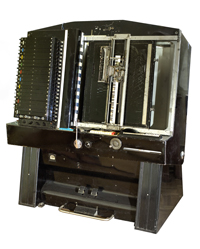 Copyright certificate N118695, USSR, applied 24.06.1957. Its name was derived from initials of the influential composer Alexander Nikolayevich Scriabin. It was remarkably close to the concept of Evgeny Sholpo's Mechanical Orchestra. The instrument was based on the scale 72 steps per octave, proposed by Boris Yankovsky, and incorporated a set of sine wave oscillators, adjusted on fixed frequencies, forming a discrete scale, covering the whole audible range with intervals between successive pitches unperceivable for human ear. Control over the system and the process of sound synthesis was carried out by means of a special graphical score with the diagram, representing a spectrum of a sound by means of drawn transparent strips, having appropriate shape and slopes, allowing to operate all set of sine wave tones synchronously and independently, controlling the sound on a spectral level, directly manipulating the overtones, erasing a difference between the pitch harmony structures and a spectral tissue of a sound. A similar principle of the graphical score was used in the legendary UPIC computer system, developed by Yanis Xenakis in 1977 in the Parisian center CEMAMu. Copyright certificate N118695, USSR, applied 24.06.1957. Its name was derived from initials of the influential composer Alexander Nikolayevich Scriabin. It was remarkably close to the concept of Evgeny Sholpo's Mechanical Orchestra. The instrument was based on the scale 72 steps per octave, proposed by Boris Yankovsky, and incorporated a set of sine wave oscillators, adjusted on fixed frequencies, forming a discrete scale, covering the whole audible range with intervals between successive pitches unperceivable for human ear. Control over the system and the process of sound synthesis was carried out by means of a special graphical score with the diagram, representing a spectrum of a sound by means of drawn transparent strips, having appropriate shape and slopes, allowing to operate all set of sine wave tones synchronously and independently, controlling the sound on a spectral level, directly manipulating the overtones, erasing a difference between the pitch harmony structures and a spectral tissue of a sound. A similar principle of the graphical score was used in the legendary UPIC computer system, developed by Yanis Xenakis in 1977 in the Parisian center CEMAMu.
In 1967 in Moscow, with the ANS Synthesizer at its core, the studio of electronic music was established. Among the composers working with the ANS were Alfred Shnitke, Sofia Gubajdulina, Edison Denisov, Eduard Artemyev, Alexander Nemtin and Stanislav Krejchi. The instrument was used for scoring many films, in particular, the early films of Andrei Tarkovsky.

EPILOGUE Researchers involved in Graphical Sound had to overcome enormous technical and theoretical (as well as more mundane) difficulties during its short existence. The results of their work were surprising and unexpected, and ahead of the group's time by decades. However, collision with the state was fatal. In less than ten years, all of their work had ended and was almost instantly forgotten. This was true not just for the group working on artificial soundtracks but also for many other areas of experimentation and advancement in science and culture during the 1930s. While post-revolution, the relationship between state and pioneers had been a complicated one, the consolidation of Stalin's dictatorship as of the mid 1920s had resulted in a political sea change that gradually increased vertical pressure on the horizontal networks of society and culture, triggering a period of control, antagonism and repression among the most outstanding, skilled and innovative representatives of Russian society. The fate of this community and the work it produced is a most unfortunate one. Its inherent incompatibility with the State's mandate for culture to promote totalitarian ideas soon predetermined its destiny. Some people chose to emigrate but many lost their lives in Stalin's torture chambers. Most survived through assimilation, deleting from their CVs any connections or affiliations to avant-garde or radical activity. At the same time, many of their names and achievements were being written out of much of the ‘official' history, forming the surrogate of the ‘Soviet Culture'. Meanwhile, the life has confirmed correctness of their foresights. Many ideas and inventions, which have been considered as utopian, are reinvented after decades abroad, we use them today not knowing their origin, and many ideas, apparently, are waiting for rebirth.
Andrei Smirnov and Lubov Pchelkina, Moscow, 2009/2011
The authors and curators: Andrey Smirnov - the senior lecturer and researcher at the Center for Electroacoustic Music at Moscow State Conservatory, the Head of the Theremin Center.
Liubov Pchelkina - the researcher at the State Tretyakov Gallery.
The exhibition revolves around the archives and collections of Marina Sholpo, Hanna Reichenshtein, Andrey Smirnov, Leon Bolotsky, Lidia Kavina, Sergei Zorin as well as the Russian State Documentary Film & Photo Archive, the Central State Museum of Musical Culture, named after Mikhail Glinka, the Polytechnic Museum, the Theremin Center at Moscow State Conservatory; the State Tretiakov Gellery Archive, Russian State Archive of Literature and Art (RGALI).
Authors of the exhibition would like to thank Marina Sholpo, Natalia Kalantarova, Rimma Moiseeva, Viktor Batalin, Tamara Kaftanova, Olga Kovaleva, Antonina Belikova, Alexandra Sveshnikova, Konstantin Dudakov, Jon Appletov (USA), Pro Arte Foundation, Center for Electroacoustic Music at Moscow State Conservatory for their help and assistance. Special gratitude to the art historian Nikolai Izvolov - the first researcher of the Graphic Sound by which diligence sound archives of tone-films and some important documents became accessible.
The first time the exhibition under the title “Sound in Z” was held in 2008 in Paris at the Museum of Modern Art ‘Palais De Tokyo' in the framework of the project by the British winner of the Turner Prize - Jeremy Deller, under the title “From One Revolution To Another” curated by Matthew Price and
Christina Steinbrecher.
Related publications:
1. Smirnov A., The book “SOUND in Z. Forgotten experiments in sound art and electronic music in early 20th century Russia”. Walther Konig, Cologne, 2013. 281 pages, in English.
2. Smirnov A., Pchelkina L.,
1917-1939. Son Z / Sound in Z. PALAIS / Palais de Tokyo Magazine, Paris, 2008, ¹7. pp. 66-77 (English and French).
3. Smirnov A., Touchless Music. Theremin. (pp. 134-136); Dancing in Tune. Terpsitone. (pp. 137-139); Rhythm' n' Light. Rhythmicon. (pp. 188-190). The book “Zauberhafte Klangmaschinen. Von der Sprechmaschine bis zur Soundkarte”. Schott Music GmbH & Co. KG, Mainz, 2008 (English and German).
4. Smirnov A., Pchelkina L., Les Pionniers Russes de'l ART du SON. Experimentations musicales. Catalogue of the exhibition Lenin Stalin et la Musique at Cite de la musique, Paris, 2010. (French).
5. Smirnov A., Son produit par la lumiere et le papier. Catalogue of the exhibition «Vois ce que j'entends», Centre des Arts Enghien-les-Bains, France, 2010. (Russian and French).
6. Smirnov A., Boris Yankovsky: Leben im Klangspektrum. Gezeichneter Klang und Klangsynthese in der Sowjetunion der 30er Jahre. Klangmaschinen zwischen Experiment und Medientechnik. Transcript Verlag, Bielefeld. Austria, 2010.
7. Smirnov A., Boykett T., Notation und visuelle Musik. Klangmaschinen zwischen Experiment und Medientechnik. Transcript Verlag, Bielefeld. Austria, 2010.
8. Smirnov A., Pchelkina L., GENERATION Z. Booklet of the Generation Z exhibition. OSA Archivum, Budapest, 2011. (English and Hungarian).
9. Smirnov A., Pchelkina L., Russian Pioneers of Sound Art in the 1920s. Catalogue of the exhibition 'Red Cavalry: Creation and Power in Soviet Russia between 1917 and 1945'. La Casa Encendida, Madrid, 2011. (English and Spanish).
10. Smirnov A., Pchelkina L., Generation Z : ReNoise in the Dis Continuity magazine of the CTM14 Festival, Berlin, 2014.
The press:
 Review from the Wire Magazine, February, 2009 (pdf) Review from the Wire Magazine, February, 2009 (pdf)
 openspace.ru - Interview with A.Smirnov about the Sound_in_Z exhibition (in Russian) openspace.ru - Interview with A.Smirnov about the Sound_in_Z exhibition (in Russian)
 Ãàçåòà «Êîììåðñàíòú» - Îòãîëîñêè ïîòåðÿííîãî çâóêà Ãàçåòà «Êîììåðñàíòú» - Îòãîëîñêè ïîòåðÿííîãî çâóêà
 Êàñïàðîâ.ru - Òðàäèöèè Ïîêîëåíèÿ Z Êàñïàðîâ.ru - Òðàäèöèè Ïîêîëåíèÿ Z
 Isolder' page: Ýêñïîçèöèÿ íà Ôåñòèâàëå íîâîé êóëüòóðû, ÖÄÕ, 23 ÿíâàðÿ Isolder' page: Ýêñïîçèöèÿ íà Ôåñòèâàëå íîâîé êóëüòóðû, ÖÄÕ, 23 ÿíâàðÿ
 Áàðò Ôàðò: Ëþäè, îáîãíàâøèå âðåìÿ. Çâóêîâîé àâàíãàðä 20-õ Áàðò Ôàðò: Ëþäè, îáîãíàâøèå âðåìÿ. Çâóêîâîé àâàíãàðä 20-õ
 Ýõî Ìîñêâû 26.03 10:15 /audio/ Ýõî Ìîñêâû 26.03 10:15 /audio/
 openspace.ru 17/03/2011 17:47 openspace.ru 17/03/2011 17:47
 Zàáûòîå ïîêîëåíèå Zàáûòîå ïîêîëåíèå
 trendclub.ru - Âûñòàâêà "Ïîêîëåíèå Z" trendclub.ru - Âûñòàâêà "Ïîêîëåíèå Z"
 ÒÁà - Ôîòîðåïîðòàæ èç Ïîëèòåõíè÷åñêîãî ìóçåÿ. Âûñòàâêà «Ïîêîëåíèå Z» ÒÁà - Ôîòîðåïîðòàæ èç Ïîëèòåõíè÷åñêîãî ìóçåÿ. Âûñòàâêà «Ïîêîëåíèå Z»
 Toutlemonde.ru - GENERATION Z - 10.01.2010 Toutlemonde.ru - GENERATION Z - 10.01.2010
 F5 - Òåõíî ðîäîì èç 20-õ… F5 - Òåõíî ðîäîì èç 20-õ…
 Âðåìÿ Íîâîñòåé N34 - 2.03.2010 - Âàäèì Êåéëèí - Áóäóùåå, êîòîðîãî íå áûëî Âðåìÿ Íîâîñòåé N34 - 2.03.2010 - Âàäèì Êåéëèí - Áóäóùåå, êîòîðîãî íå áûëî
 russia.ru - 28.09.2009- Îíè ðèñîâàëè ìóçûêîé /video/ russia.ru - 28.09.2009- Îíè ðèñîâàëè ìóçûêîé /video/
 ÍÒÂ 25.02.2010 Èõ íàçûâàëè ïèîíåðàìè çâóêà /video/ ÍÒÂ 25.02.2010 Èõ íàçûâàëè ïèîíåðàìè çâóêà /video/
 Òåëåêàíàë «Êóëüòóðà» 11.03.2011 14:50 /video/ Òåëåêàíàë «Êóëüòóðà» 11.03.2011 14:50 /video/
 A-ONE NEWS. 28.01.2010 - Ïîêîëåíèå Z /video/ A-ONE NEWS. 28.01.2010 - Ïîêîëåíèå Z /video/
 Lecture by A. Smirnov at ProArte Foundation, St.Petersburg on 26.02.2010. /video/ Lecture by A. Smirnov at ProArte Foundation, St.Petersburg on 26.02.2010. /video/
 Ýêñêóðñèÿ ïî âûñòàâêå Ïîêîëåíèå Z. À.Ñìèðíîâ. Ïîëèòåõíè÷åñêèé ìóçåé /video/ Ýêñêóðñèÿ ïî âûñòàâêå Ïîêîëåíèå Z. À.Ñìèðíîâ. Ïîëèòåõíè÷åñêèé ìóçåé /video/
 Andrey Smirnov's Sound In Z from The Wire Magazine. 2013. /âèäåî/ Andrey Smirnov's Sound In Z from The Wire Magazine. 2013. /âèäåî/
 Generation Z : ReNoise. Russian Pioneers of Sound Art and Musical Technology in the Early 20th Century at Kunstraum Kreuzberg, Berlin. InEnArt, 2014. Generation Z : ReNoise. Russian Pioneers of Sound Art and Musical Technology in the Early 20th Century at Kunstraum Kreuzberg, Berlin. InEnArt, 2014.
 Generation Z : ReNoise at RANDFORM Generation Z : ReNoise at RANDFORM
 CTM/Transmediale 2014: Back when Russia was cool. EXBERLINER, January 27, 2014 . CTM/Transmediale 2014: Back when Russia was cool. EXBERLINER, January 27, 2014 .
 Agata Pyzik: Waves of the future: rediscovering Russia's sound art pioneers. The Calvert Journal, 15.08.2013. Agata Pyzik: Waves of the future: rediscovering Russia's sound art pioneers. The Calvert Journal, 15.08.2013.
 Agata Pyzik: Music of Full Communism? Early Musical Experiment in Soviet Union. 2013. Agata Pyzik: Music of Full Communism? Early Musical Experiment in Soviet Union. 2013.
|
 Generation Z exhibition is a part of an ongoing project by Andrei Smirnov and Liubov Pchelkina that is attempting to reconstruct the censored history and culture of the Russian artistic Utopia of the 1910-1920s – a kind of 'network culture' of revolutionaries in art who realized seemingly unrealizable projects in sound, invented new musical machines, and who explored concepts and methods that offered a promising basis for future scientific and cultural development. The exhibition offers an introduction to some of the key figures of the period and their areas of research.
Generation Z exhibition is a part of an ongoing project by Andrei Smirnov and Liubov Pchelkina that is attempting to reconstruct the censored history and culture of the Russian artistic Utopia of the 1910-1920s – a kind of 'network culture' of revolutionaries in art who realized seemingly unrealizable projects in sound, invented new musical machines, and who explored concepts and methods that offered a promising basis for future scientific and cultural development. The exhibition offers an introduction to some of the key figures of the period and their areas of research. 
 While the history of Russian post-revolutionary avant-garde art and music is fairly well documented, the inventions and discoveries, names and destinies of the community of researchers of sound, creators of musical machines and noise orchestras and founders of new musical technologies have been largely forgotten except, perhaps, Leon Theremin, well known as an inventor of the first commercially produced electronic musical instrument, the Theremin (1920). As composer and author Albert Glinsky asserts, ‘this frequently clumsy instrument was the first foray into the brave new world of electronic music.' Its arrival heralded a new, technologically based trend in the arts. As a physicist, musician and engineer he worked on the development of innumerable projects, often trying to combine music with colour, with gesture, scent and touch. Having worked at the crossroads of creative technology and espionage, it is hardly possible today to imagine any synthesizers, burglar alarms or automatic doors without his pioneering research.
While the history of Russian post-revolutionary avant-garde art and music is fairly well documented, the inventions and discoveries, names and destinies of the community of researchers of sound, creators of musical machines and noise orchestras and founders of new musical technologies have been largely forgotten except, perhaps, Leon Theremin, well known as an inventor of the first commercially produced electronic musical instrument, the Theremin (1920). As composer and author Albert Glinsky asserts, ‘this frequently clumsy instrument was the first foray into the brave new world of electronic music.' Its arrival heralded a new, technologically based trend in the arts. As a physicist, musician and engineer he worked on the development of innumerable projects, often trying to combine music with colour, with gesture, scent and touch. Having worked at the crossroads of creative technology and espionage, it is hardly possible today to imagine any synthesizers, burglar alarms or automatic doors without his pioneering research.  August 31, 1938 he was illegally taken on board Starry Bolshevik ship on which he has transported over 1000 kilograms of electronic equipment to Russia. His intension was to develop an electronic music studio in Soviet Russia. It is not surprising that all equipment was confiscated by Soviet customs. Shortly after arrival in March 1939 Leon Theremin was arrested and condemned for 8 years of GULAG camps. Fortunately after one year in Kolima (the worst place in Siberia) he was moved to Moscow “Sharaga” – special prison for scientists. After release in 1947 he remained to work for KGB until his retirement in 1962 when he moved to Acoustical Laboratory at Moscow State Conservatory (former NIMI), where he tried to revive most of his American inventions and research. On April 1967 an article about him was published by the New York Times, which caused a fast and only possible in the USSR reaction: Leon Theremin was removed from his position and kicked out of the Moscow State Conservatory. The rest of his life Leon Theremin has spent working at Moscow State University in a position of technician at the Physics Department.
August 31, 1938 he was illegally taken on board Starry Bolshevik ship on which he has transported over 1000 kilograms of electronic equipment to Russia. His intension was to develop an electronic music studio in Soviet Russia. It is not surprising that all equipment was confiscated by Soviet customs. Shortly after arrival in March 1939 Leon Theremin was arrested and condemned for 8 years of GULAG camps. Fortunately after one year in Kolima (the worst place in Siberia) he was moved to Moscow “Sharaga” – special prison for scientists. After release in 1947 he remained to work for KGB until his retirement in 1962 when he moved to Acoustical Laboratory at Moscow State Conservatory (former NIMI), where he tried to revive most of his American inventions and research. On April 1967 an article about him was published by the New York Times, which caused a fast and only possible in the USSR reaction: Leon Theremin was removed from his position and kicked out of the Moscow State Conservatory. The rest of his life Leon Theremin has spent working at Moscow State University in a position of technician at the Physics Department.  While the career of Theremin the physicist began at the Institute for Physics and Technology in Petrograd, his musical career has begun in Moscow, at the State Institute for Musical Science (GIMN) which was founded in Moscow in 1921 in an attempt to centralize all activities related to musical science including disciplines such as acoustics, musicology, psychology, physiology, construction of new musical instruments and ethnomusicology. Nikolai Garbuzov was elected director.
While the career of Theremin the physicist began at the Institute for Physics and Technology in Petrograd, his musical career has begun in Moscow, at the State Institute for Musical Science (GIMN) which was founded in Moscow in 1921 in an attempt to centralize all activities related to musical science including disciplines such as acoustics, musicology, psychology, physiology, construction of new musical instruments and ethnomusicology. Nikolai Garbuzov was elected director.  In 1931 GIMN was closed and in 1933 Garbuzov established a new Research Institute for Musical Science (NIMI) at Moscow State Conservatory where in 1940s it was renamed as the Acoustical Laboratory. In the realm of music and its technology GIMN/NIMI was the highest-level organization in Moscow. Projects from all over Soviet Russia seeking a patent or financial support needed a positive review from the appropriate GIMN/NIMI experts. As many of these experts were involved in similar research or had different aesthetic views, their responses were often negative, based on biased opinions and self-interest rather than scholarship, discourse and the greater good.
In 1931 GIMN was closed and in 1933 Garbuzov established a new Research Institute for Musical Science (NIMI) at Moscow State Conservatory where in 1940s it was renamed as the Acoustical Laboratory. In the realm of music and its technology GIMN/NIMI was the highest-level organization in Moscow. Projects from all over Soviet Russia seeking a patent or financial support needed a positive review from the appropriate GIMN/NIMI experts. As many of these experts were involved in similar research or had different aesthetic views, their responses were often negative, based on biased opinions and self-interest rather than scholarship, discourse and the greater good. In 1916 a student at the Neurological Institute in Petrograd Denis Kaufman (1896-1954) (aka Dziga Vertov) attempted what would now be called sound poetry and audio art. As he put it: ‘I decided to include the entire audible world into the concept of “Hearing.” It was during this time that I attempted to draw up the sounds of a lumber-mill. [...] I tried to describe the audio impression of the lumber-mill in the way a blind person would perceive it. In the beginning I wrote down words, but then I attempted to capture all of these noises with letters. [...] It also concerned my experiments with gramophone recordings, where from the separate fragments of recordings on
In 1916 a student at the Neurological Institute in Petrograd Denis Kaufman (1896-1954) (aka Dziga Vertov) attempted what would now be called sound poetry and audio art. As he put it: ‘I decided to include the entire audible world into the concept of “Hearing.” It was during this time that I attempted to draw up the sounds of a lumber-mill. [...] I tried to describe the audio impression of the lumber-mill in the way a blind person would perceive it. In the beginning I wrote down words, but then I attempted to capture all of these noises with letters. [...] It also concerned my experiments with gramophone recordings, where from the separate fragments of recordings on  gramophone disks a new composition was created. But I was not satisfied experimenting with available prerecorded sounds'. Being frustrated, he has switched to film to o rganize not the audible, but the visible world.
gramophone disks a new composition was created. But I was not satisfied experimenting with available prerecorded sounds'. Being frustrated, he has switched to film to o rganize not the audible, but the visible world.  Arseny Avraamov (Krasnokutsky) (1885-1944) was a composer, performance instigator, music journalist and creator of the first ever artificial soundtrack. In a series of articles from 1914-1916 he developed the theory of microtonal ‘Ultrachromatic' music and invented special instruments to perform it. Shortly after the October Revolution Avraamov proposed to the Commissar of Education, Anatoly Lunacharsky, a project to burn all pianos – symbols of the despised twelve-tone, octave-based ‘well tempered' scale, which he believed had adversely affected human hearing for several hundred years.
Arseny Avraamov (Krasnokutsky) (1885-1944) was a composer, performance instigator, music journalist and creator of the first ever artificial soundtrack. In a series of articles from 1914-1916 he developed the theory of microtonal ‘Ultrachromatic' music and invented special instruments to perform it. Shortly after the October Revolution Avraamov proposed to the Commissar of Education, Anatoly Lunacharsky, a project to burn all pianos – symbols of the despised twelve-tone, octave-based ‘well tempered' scale, which he believed had adversely affected human hearing for several hundred years.  In the spring of 1917 in Petrograd the Leonardo da Vinci Society was founded by Arseny Avraamov and the young inventor Evgeny Sholpo (1891-1951) accompanied by the mathematician and musicologist Sergei Dianin. Their objective was to unite efforts to produce a revolution in music theory and techniques based on the cross-connection of the arts and sciences. They declared that academic views on music theory were dull and scholastic, and that techniques relating to it were old fashioned, proclaiming that both were becoming increasingly outdated. In the summer of 1917 in Petrograd Evgany Sholpo wrote a science-fiction essay entitled ‘The Enemy of Music' in which he described a sound machine named the Mechanical Orchestra, capable of synthesizing any sound and producing music according to a special graphical score without any need for a performer. The instrument was based on the same principles as the ANS Synthesizer, built 35 years later by Evgeny Murzin. According to Sholpo's description the instrument incorporated a set of sine wave oscillators, based on numerous Helmholtz tuning forks, adjusted on fixed frequencies, forming a discrete scale, covering the whole audible range with intervals between successive pitches unperceivable to the human ear. Control over the system and the process of sound synthesis was to be carried out by means of a special graphical score with the diagram, representing a spectrum of a sound by means of cut-out transparent strips, having appropriate shape and slopes, allowing a complete set of sine wave tones to be operated synchronously and independently, controlling the sound on a spectral level, directly manipulating the overtones, erasing the difference between the pitch-based harmony structures and the spectral tissue of a sound.
In the spring of 1917 in Petrograd the Leonardo da Vinci Society was founded by Arseny Avraamov and the young inventor Evgeny Sholpo (1891-1951) accompanied by the mathematician and musicologist Sergei Dianin. Their objective was to unite efforts to produce a revolution in music theory and techniques based on the cross-connection of the arts and sciences. They declared that academic views on music theory were dull and scholastic, and that techniques relating to it were old fashioned, proclaiming that both were becoming increasingly outdated. In the summer of 1917 in Petrograd Evgany Sholpo wrote a science-fiction essay entitled ‘The Enemy of Music' in which he described a sound machine named the Mechanical Orchestra, capable of synthesizing any sound and producing music according to a special graphical score without any need for a performer. The instrument was based on the same principles as the ANS Synthesizer, built 35 years later by Evgeny Murzin. According to Sholpo's description the instrument incorporated a set of sine wave oscillators, based on numerous Helmholtz tuning forks, adjusted on fixed frequencies, forming a discrete scale, covering the whole audible range with intervals between successive pitches unperceivable to the human ear. Control over the system and the process of sound synthesis was to be carried out by means of a special graphical score with the diagram, representing a spectrum of a sound by means of cut-out transparent strips, having appropriate shape and slopes, allowing a complete set of sine wave tones to be operated synchronously and independently, controlling the sound on a spectral level, directly manipulating the overtones, erasing the difference between the pitch-based harmony structures and the spectral tissue of a sound.  The Central Institute of Labour (CIT) was established in 1920 by the writer, politician and polymath Alexei Gastev (1882-1939), who was one of the most popular and outstanding proletarian poets of the early post-revolutionary Russia. He was convinced that CIT was his main artistic creation. Fascinated by Taylorism and Fordism, he has led a popular movement for the ‘scientific organization of labor' (NOT) to represent a Marxian variant of cybernetics. It was Gastev who coined the term Bio-mechanics, which was widely used then in the psychology of labour as well as in the field of theatre, most evidently in the work of producer, director and actor Vsevolod Meyerhold. It was scientific research with an interdisciplinary and broad-ranging agenda. And at the foundation of this approach lay a powerful manmachine metaphor associating, in particular, with the concept of Organoprojection (1919) by Pavel Florensky - Russian
The Central Institute of Labour (CIT) was established in 1920 by the writer, politician and polymath Alexei Gastev (1882-1939), who was one of the most popular and outstanding proletarian poets of the early post-revolutionary Russia. He was convinced that CIT was his main artistic creation. Fascinated by Taylorism and Fordism, he has led a popular movement for the ‘scientific organization of labor' (NOT) to represent a Marxian variant of cybernetics. It was Gastev who coined the term Bio-mechanics, which was widely used then in the psychology of labour as well as in the field of theatre, most evidently in the work of producer, director and actor Vsevolod Meyerhold. It was scientific research with an interdisciplinary and broad-ranging agenda. And at the foundation of this approach lay a powerful manmachine metaphor associating, in particular, with the concept of Organoprojection (1919) by Pavel Florensky - Russian  Orthodox theologian, philosopher, mathematician and inventor, executed by NKVD in late 1930s.
Orthodox theologian, philosopher, mathematician and inventor, executed by NKVD in late 1930s.  (1896–1966) - the Institute's leading physiologist, who conducted a series of experiments that measured the trajectories and speeds of human limbs, while his subjects performed various labour tasks.
(1896–1966) - the Institute's leading physiologist, who conducted a series of experiments that measured the trajectories and speeds of human limbs, while his subjects performed various labour tasks.  The ideas, projects and artworks created during 1910-20-s are often considered utopian. However, there is no general definition or style that can lay claim to characterize the art of the late 1910s and 1920s. Nor does this time interval fit neatly into any system of representation about the unity of culture or its progressive development. A term that sought to capture the essence of the period was proposed by the artist and philosopher Solomon Nikritin (1898-1965). Projectionism (from the Latin 'projectus') was intended to reflect the urge to rush ahead, or more accurately, to rush into the future. He applied this term not only to new approaches in painting and methods of art criticism, but also to the methodology of constructing a new society, to which it was considered necessary to aspire. In 1919 Nikritin developed his fundamental theory of Projectionism. According to his philosophy, the rational essence of nature is the highest goal of technology and culture. In his manifesto he asserted: ‘The Artist is not a producer of consumer goods (a cupboard, a picture), but of (PROJECTIONS) METHOD – the organization of matter.'
The ideas, projects and artworks created during 1910-20-s are often considered utopian. However, there is no general definition or style that can lay claim to characterize the art of the late 1910s and 1920s. Nor does this time interval fit neatly into any system of representation about the unity of culture or its progressive development. A term that sought to capture the essence of the period was proposed by the artist and philosopher Solomon Nikritin (1898-1965). Projectionism (from the Latin 'projectus') was intended to reflect the urge to rush ahead, or more accurately, to rush into the future. He applied this term not only to new approaches in painting and methods of art criticism, but also to the methodology of constructing a new society, to which it was considered necessary to aspire. In 1919 Nikritin developed his fundamental theory of Projectionism. According to his philosophy, the rational essence of nature is the highest goal of technology and culture. In his manifesto he asserted: ‘The Artist is not a producer of consumer goods (a cupboard, a picture), but of (PROJECTIONS) METHOD – the organization of matter.' The method, therefore, invented by the artist, becomes the purpose of the creative process. The intention was for new ideas to transfer creative energy into further development. In the context of ‘projecting the method' even faults and paradoxes gained a new constructive sense and value. In the early 1920s much project-based research took place that could be considered within the framework of Projectionism, including Alexei Gastev's Art of Movement exhibitions, the concert-lectures by Leon Theremin, and Arseny Avraamov's concert series Music of the Future, in which the author demonstrated his practical ideas regarding the future of musical harmony and techniques, rather than presenting finished musical pieces.
The method, therefore, invented by the artist, becomes the purpose of the creative process. The intention was for new ideas to transfer creative energy into further development. In the context of ‘projecting the method' even faults and paradoxes gained a new constructive sense and value. In the early 1920s much project-based research took place that could be considered within the framework of Projectionism, including Alexei Gastev's Art of Movement exhibitions, the concert-lectures by Leon Theremin, and Arseny Avraamov's concert series Music of the Future, in which the author demonstrated his practical ideas regarding the future of musical harmony and techniques, rather than presenting finished musical pieces.  each part within the movement of the body, for the development of this movement, and for its nuances and transitions, including vocal resonance. All this was tinged by the emotional score which became the basis of the entire action". Many instances of the use of current multimedia technologies were already being explored in the performances of the Projection Theatre in the 1920s. To create the most complicated scores of sounds, gestures, movements and emotional states needed for his research, actors were involved in a daily routine of exercises and psychological training. Specially made diagrams specified the distribution of various emotions in time such as anger, melancholy and sadness by representing them as percentages on a graph. Large screens behind the stage were intended to produce a dynamical film projection as a part of the performance and virtual characters from the film projection appeared to interact with the actors on the stage.
each part within the movement of the body, for the development of this movement, and for its nuances and transitions, including vocal resonance. All this was tinged by the emotional score which became the basis of the entire action". Many instances of the use of current multimedia technologies were already being explored in the performances of the Projection Theatre in the 1920s. To create the most complicated scores of sounds, gestures, movements and emotional states needed for his research, actors were involved in a daily routine of exercises and psychological training. Specially made diagrams specified the distribution of various emotions in time such as anger, melancholy and sadness by representing them as percentages on a graph. Large screens behind the stage were intended to produce a dynamical film projection as a part of the performance and virtual characters from the film projection appeared to interact with the actors on the stage.  In 1921-23 performances of the Projection Theatre, the Foregger Studio as well as sound experiments at the Proletkult Studio, directed by Sergei Eisenstein, have provoke a fashion on Noise Music and Noise Orchestras. As Rene Fulop-Miller has noted in 1926: ‘The same idea also ruled the true proletarian music: it, too, emphasized the rhythms which corresponded to the universal and impersonal elements of humanity. The new music had to embrace all the noises of the mechanical age, the rhythm of the machine, the din of the great city and the factory, the whirring of driving-belts, the clattering of motors, and the shrill notes of motor-horns.
In 1921-23 performances of the Projection Theatre, the Foregger Studio as well as sound experiments at the Proletkult Studio, directed by Sergei Eisenstein, have provoke a fashion on Noise Music and Noise Orchestras. As Rene Fulop-Miller has noted in 1926: ‘The same idea also ruled the true proletarian music: it, too, emphasized the rhythms which corresponded to the universal and impersonal elements of humanity. The new music had to embrace all the noises of the mechanical age, the rhythm of the machine, the din of the great city and the factory, the whirring of driving-belts, the clattering of motors, and the shrill notes of motor-horns.  Many inventors patented new sound machines specially intended for performance of the Noise Music. Some devices based on electro-optical, electro-mechanical and newest electronic technologies were ahead of their time by decades. Among them the Electro-Musical Device invented by J.A. Pakhuchi (Patent #19675, filed December 26, 1929) with application of a buzzer and a pedal rheostat for change of intensity of a sound. ‘Mechanical keyboard instrument for the reproduction of speech, singing and various sounds' invented in 1925 by D.G. Tambovtsev (Patent N6309. Filed May 9, 1925) was a kind of proto-sampler, very similar to the famous Mellotron, popular in 1970-s. It comprises a system of infinite loops of steel wire with prerecorded sounds, movable against the poles of electromagnets (magnetic heads), corresponding to each key of the keyboard. N.M. Molodsov invented a ‘Device for sound on film reproduction, intended to create illusion of the spatial movement of sounding objects by means of sound film' (Copyright certificate on the invention N49350. Filed June 8, 1934). A.G. Mashkovich invented some extraordinary devices to produce sound effects. Electro - Optical Musical Instrument, invented by Sergeev in 1926, was very similar to the famous Rhythmicon, built by Leon Theremin in 1931 and based on principle of the optical siren. It was a kind of electro-optical sound synthesizer, incorporating a sequencer to program scores with complicated rhythms and harmonies.
Many inventors patented new sound machines specially intended for performance of the Noise Music. Some devices based on electro-optical, electro-mechanical and newest electronic technologies were ahead of their time by decades. Among them the Electro-Musical Device invented by J.A. Pakhuchi (Patent #19675, filed December 26, 1929) with application of a buzzer and a pedal rheostat for change of intensity of a sound. ‘Mechanical keyboard instrument for the reproduction of speech, singing and various sounds' invented in 1925 by D.G. Tambovtsev (Patent N6309. Filed May 9, 1925) was a kind of proto-sampler, very similar to the famous Mellotron, popular in 1970-s. It comprises a system of infinite loops of steel wire with prerecorded sounds, movable against the poles of electromagnets (magnetic heads), corresponding to each key of the keyboard. N.M. Molodsov invented a ‘Device for sound on film reproduction, intended to create illusion of the spatial movement of sounding objects by means of sound film' (Copyright certificate on the invention N49350. Filed June 8, 1934). A.G. Mashkovich invented some extraordinary devices to produce sound effects. Electro - Optical Musical Instrument, invented by Sergeev in 1926, was very similar to the famous Rhythmicon, built by Leon Theremin in 1931 and based on principle of the optical siren. It was a kind of electro-optical sound synthesizer, incorporating a sequencer to program scores with complicated rhythms and harmonies.  Perhaps the most well known project of the epoch of Noise Music was the Symphony of Sirens by Arseny Avraamov, inspired by the poetry of Alexei Gastev. It was first staged in the port town of Baku in 1922 in celebration of the 5th anniversary of the Revolution. This epic spectacle featured a cast of choirs, the foghorns of the entire Caspian flotilla, two batteries of artillery guns, a number of infantry regiments including a machine-gun division, hydroplanes, and all the town's factory sirens. The conductor, posted on a purpose-built tower, signaled various sound units with coloured flags and pistol shots. A central sound-machine called the 'Magistral' contained 50 steam whistles controlled by a crowd of musicians following 'text-scores'.
Perhaps the most well known project of the epoch of Noise Music was the Symphony of Sirens by Arseny Avraamov, inspired by the poetry of Alexei Gastev. It was first staged in the port town of Baku in 1922 in celebration of the 5th anniversary of the Revolution. This epic spectacle featured a cast of choirs, the foghorns of the entire Caspian flotilla, two batteries of artillery guns, a number of infantry regiments including a machine-gun division, hydroplanes, and all the town's factory sirens. The conductor, posted on a purpose-built tower, signaled various sound units with coloured flags and pistol shots. A central sound-machine called the 'Magistral' contained 50 steam whistles controlled by a crowd of musicians following 'text-scores'.  The late 1920s was also the period in which sound was being developed to accompany films and animations in Russia. Among the first Soviet sound movies ever created was ‘Piatiletka. Plan velikih rabot' (Plan of Great Works) by Abram Room.The group, working on this film in 1929 at Shorin's Central Laboratory of Wire Communication in Leningrad, included the painter, book illustrator and animator Mikhail Tsekhanovsky, the chief of the composer's brigade Arseny Avraamov and the inventor Evgeny Sholpo. When in October of that year the first roll of film was developed, it was Tsekhanovsky who voiced the idea: ‘What if we take some Egyptian or ancient Greek ornaments as a sound track? Perhaps we will hear some unknown archaic music?' He was referring to the shapes and outlines of vases and how these could be used as if wave forms to generate sound. It was at this precise moment that Graphical Sound techniques were invented. The next day they were already furiously at work on experiments in what they referred to variously as ‘ornamental', ‘drawn', ‘paper', ‘graphical', ‘artificial' or ‘synthetic' sound. By 1936 there were four main trends of Graphical Sound in Soviet Russia: hand-drawn Ornamental Sound (Avraamov, early Boris Yankovsky (1905-1973)); hand-made Paper Sound (Nikolai Voinov (1900-1958)); Variophone or automated Paper Sound (Evgeny Sholpo, Georgy Rimsky-Korsakov); and the spectral syntones technique (Boris Yankovsky).
The late 1920s was also the period in which sound was being developed to accompany films and animations in Russia. Among the first Soviet sound movies ever created was ‘Piatiletka. Plan velikih rabot' (Plan of Great Works) by Abram Room.The group, working on this film in 1929 at Shorin's Central Laboratory of Wire Communication in Leningrad, included the painter, book illustrator and animator Mikhail Tsekhanovsky, the chief of the composer's brigade Arseny Avraamov and the inventor Evgeny Sholpo. When in October of that year the first roll of film was developed, it was Tsekhanovsky who voiced the idea: ‘What if we take some Egyptian or ancient Greek ornaments as a sound track? Perhaps we will hear some unknown archaic music?' He was referring to the shapes and outlines of vases and how these could be used as if wave forms to generate sound. It was at this precise moment that Graphical Sound techniques were invented. The next day they were already furiously at work on experiments in what they referred to variously as ‘ornamental', ‘drawn', ‘paper', ‘graphical', ‘artificial' or ‘synthetic' sound. By 1936 there were four main trends of Graphical Sound in Soviet Russia: hand-drawn Ornamental Sound (Avraamov, early Boris Yankovsky (1905-1973)); hand-made Paper Sound (Nikolai Voinov (1900-1958)); Variophone or automated Paper Sound (Evgeny Sholpo, Georgy Rimsky-Korsakov); and the spectral syntones technique (Boris Yankovsky).  It was Avraamov who completed the first artificial sound tracks in 1930. The same year Evgeny Sholpo invents the Variophone. It was a continuation of research that Sholpo had been conducting since the 1910s when he was working on ‘Performer-less music'. The first version of Variophone was built in 1931 by Sholpo together with composer Georgy Rimsky-Korsakov (the son of the famous composer Nikolai Rimsky-Korsakov). It was capable of producing artificial soundtracks by means of automated Paper Sound techniques.
It was Avraamov who completed the first artificial sound tracks in 1930. The same year Evgeny Sholpo invents the Variophone. It was a continuation of research that Sholpo had been conducting since the 1910s when he was working on ‘Performer-less music'. The first version of Variophone was built in 1931 by Sholpo together with composer Georgy Rimsky-Korsakov (the son of the famous composer Nikolai Rimsky-Korsakov). It was capable of producing artificial soundtracks by means of automated Paper Sound techniques.  any soundtracks for movies and cartoons were created using the Variophone. Among the most accomplished pieces recorded with the Variophone in 1933-34 were ‘The Carburettor Suite' by G. Rimsky-Korsakov, ‘Waltz' by N.Timofeev, ‘Flight of the Valkyries' by Richard Wagner, and 6th Rhapsody by Franz Liszt. In 1941 during the blockade of Leningrad, together with composer Igor Boldirev, Sholpo synthesized one of his most experimental pieces – the soundtrack to the cartoon ‘Sterviatniki' (The Vultures). Although aesthetically these works are similar to Walter Carlos' ‘Switched-on Bach' (1968) and sound like 'eight-bit music', the main difference is in their timing. In 1918 Sholpo developed special tools - the Melograph and Autopianograph - to register the temporal characteristics of live musical performance. Much electronic music has a rigid tempo, like a metronome; Sholpo was able to simulate more subtle variations in tempo such as Rubato, Rallentando and Accelerando, based on his carful analyses of the live piano performances by the best pianists.
any soundtracks for movies and cartoons were created using the Variophone. Among the most accomplished pieces recorded with the Variophone in 1933-34 were ‘The Carburettor Suite' by G. Rimsky-Korsakov, ‘Waltz' by N.Timofeev, ‘Flight of the Valkyries' by Richard Wagner, and 6th Rhapsody by Franz Liszt. In 1941 during the blockade of Leningrad, together with composer Igor Boldirev, Sholpo synthesized one of his most experimental pieces – the soundtrack to the cartoon ‘Sterviatniki' (The Vultures). Although aesthetically these works are similar to Walter Carlos' ‘Switched-on Bach' (1968) and sound like 'eight-bit music', the main difference is in their timing. In 1918 Sholpo developed special tools - the Melograph and Autopianograph - to register the temporal characteristics of live musical performance. Much electronic music has a rigid tempo, like a metronome; Sholpo was able to simulate more subtle variations in tempo such as Rubato, Rallentando and Accelerando, based on his carful analyses of the live piano performances by the best pianists.  In 1939 Yankovsky met Evgeny Murzin (1914-1970) – a young inventor, fascinated by the idea of universal tool for sound synthesis and after a year of conversations the final concept of the future instrument was formulated. In 1957 Murzin completed and patented a photo-electronic musical instrument called the ANS Synthesizer. [Evgeny Murzin. 'Photoelectrichesky sintezator muziki' (The Photoelectric Synthesizer of Music).
In 1939 Yankovsky met Evgeny Murzin (1914-1970) – a young inventor, fascinated by the idea of universal tool for sound synthesis and after a year of conversations the final concept of the future instrument was formulated. In 1957 Murzin completed and patented a photo-electronic musical instrument called the ANS Synthesizer. [Evgeny Murzin. 'Photoelectrichesky sintezator muziki' (The Photoelectric Synthesizer of Music).  Copyright certificate N118695, USSR, applied 24.06.1957. Its name was derived from initials of the influential composer Alexander Nikolayevich Scriabin. It was remarkably close to the concept of Evgeny Sholpo's Mechanical Orchestra. The instrument was based on the scale 72 steps per octave, proposed by Boris Yankovsky, and incorporated a set of sine wave oscillators, adjusted on fixed frequencies, forming a discrete scale, covering the whole audible range with intervals between successive pitches unperceivable for human ear. Control over the system and the process of sound synthesis was carried out by means of a special graphical score with the diagram, representing a spectrum of a sound by means of drawn transparent strips, having appropriate shape and slopes, allowing to operate all set of sine wave tones synchronously and independently, controlling the sound on a spectral level, directly manipulating the overtones, erasing a difference between the pitch harmony structures and a spectral tissue of a sound. A similar principle of the graphical score was used in the legendary UPIC computer system, developed by Yanis Xenakis in 1977 in the Parisian center CEMAMu.
Copyright certificate N118695, USSR, applied 24.06.1957. Its name was derived from initials of the influential composer Alexander Nikolayevich Scriabin. It was remarkably close to the concept of Evgeny Sholpo's Mechanical Orchestra. The instrument was based on the scale 72 steps per octave, proposed by Boris Yankovsky, and incorporated a set of sine wave oscillators, adjusted on fixed frequencies, forming a discrete scale, covering the whole audible range with intervals between successive pitches unperceivable for human ear. Control over the system and the process of sound synthesis was carried out by means of a special graphical score with the diagram, representing a spectrum of a sound by means of drawn transparent strips, having appropriate shape and slopes, allowing to operate all set of sine wave tones synchronously and independently, controlling the sound on a spectral level, directly manipulating the overtones, erasing a difference between the pitch harmony structures and a spectral tissue of a sound. A similar principle of the graphical score was used in the legendary UPIC computer system, developed by Yanis Xenakis in 1977 in the Parisian center CEMAMu. 